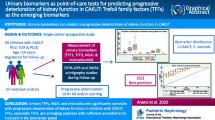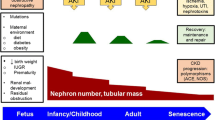Abstract
Background
Diagnosis of renal function impairment and deterioration in congenital urinary tract obstruction (UTO) continues to be extremely challenging. Use of renal biomarkers in this setting may favor early renal injury detection, allowing for a reliable choice of optimal therapeutic options and prevention or minimization of definitive renal damage.
Methods
This longitudinal, prospective study analyzed the first-year profile of two serum renal biomarkers: creatinine (sCr) and cystatin C (sCyC); and six urinary renal biomarkers: neutrophil gelatinase-associated lipocalin (NGAL), kidney injury molecule-1 (KIM-1), transforming growth factor beta-1 (TGF-β1), retinol-binding protein (RBP), cystatin C (uCyC), and microalbuminuria (μALB) in a cohort of 37 infants with UTO divided into three subgroups: 14/37 with unilateral hydro(uretero)nephrosis, 13/37 with bilateral hydro(uretero)nephrosis, and 10/37 patients with lower urinary tract obstruction (LUTO), compared with 24 healthy infants matched by gestational age and birth weight.
Results
All urine biomarkers showed significantly higher values at the first month of life (p ≤ 0.009), while NGAL (p = 0.005), TGF-ß1 (p < 0.001), and μALB (p < 0.001) were high since birth compared to controls. Best single biomarker performances were RBP in bilateral hydronephrosis and LUTO subgroups and KIM-1 in unilateral hydronephrosis subgroup. Best biomarker combination results for all subgroups were obtained by matching RBP with TGF-ß1 or KIM-1 and NGAL with CyC ([AUC] ≤ 0.934; sensitivity ≤ 92.4%; specificity ≤ 92.8%).
Conclusions
RBP, NGAL, KIM-1, TGF-ß1, and CyC, alone and especially in combination, are relatively efficient in identifying surgically amenable congenital UTO and could be of practical use in indicating on-time surgery.





Similar content being viewed by others
References
Peters CA (1995) Urinary tract obstruction in children. J Urol 154:1874–1884
Lee RS, Cendron M, Kinnamon DD, Nguyen HT (2006) Antenatal hydronephrosis as a predictor of postnatal outcome: a meta-analysis. Pediatrics 118:586–593
Dilly AO, Scott JE, Plant ND, Robson SC (2005) Diagnosis and outcome of fetal lower urinary tract obstruction in the northern region of England. Prenat Diagn 25:7–13
Ismaili K, Hall M, Donner C, Thomas D, Vermeylen D, Avni FE (2003) Results of systematic screening for minor degrees of fetal renal pelvis dilatation in an unselected population. Am J Obstet Gynecol 188:242–246
Wuhl E, van Stralen K, Verrina E, Bjerre A, Wanner C, Heaf JG, Zurriaga O, Hoitsma A, Niaudet P, Palsson R, Ravani P, Jager KJ, Schaefer F (2013) Timing and outcome of renal replacement therapy in patients with congenital malformations of the kidney and urinary tract. Clin J Am Soc Nephrol 8:67–74
Murer L, Benetti E, Centi S, Della Vella M, Artifoni L, Capizzi A, Zucchetta P, Del Prete D, Carasi C, Montini G, Rigamonti W, Zaccello G (2006) Clinical and molecular markers of chronic interstitial nephropathy in congenital unilateral ureteropelvic junction obstruction. J Urol 176:2668–2673
Truong LD, Gaber L, Eknoyan G (2011) Obstructive uropathy. Contrib Nephrol 169:311–326
Klein J, Gonzalez J, Miravete M, Caubet C, Chaaya R, Decramer S, Bandin F, Bascands JL, Buffin-Meyer B, Schanstra JP (2011) Congenital ureteropelvic junction obstruction: human disease and animal models. Int J Exp Pathol 92:168–192
Chevalier RL, Thornhill BA, Forbes MS, Kiley SC (2010) Mechanisms of renal injury and progression of renal disease in congenital obstructive nephropathy. Pediatr Nephrol 25:687–697
Huang W, Peters C, Zurakowski D, Borer JG, Diamond DA, Bauer SB, McLellan DL, Rosen S (2006) Renal biopsy in congenital ureteropelvic junction obstruction: evidence for parenchymal mal-development. Kidney Int 69:137–143
Morris RK, Malin GL, Quinlan-Jones E, Middleton LJ, Hemming K, Burke D, Daniels JP, Khan KS, Deeks J, Kilby MD (2013) Percutaneous vesicoamniotic shunting versus conservative management for fetal lower urinary tract obstruction (PLUTO): a randomised trial. Lancet 382:1496–1506
Morris RK, Kilby MD (2008) Congenital urinary tract obstruction. Best Pract Res Clin Obstet Gynaecol 22:97–122
Chevalier RL, Peters CA (2003) Congenital urinary tract obstruction: Proceedings of the State-Of-The-Art Strategic Planning Workshop-National Institutes of Health, Bethesda, Maryland, USA, 11-12 March 2002. Pediatr Nephrol 18:576–606
Chevalier RL (2008) Chronic partial ureteral obstruction and the developing kidney. Pediatr Radiol 38:S35–S40
Chevalier RL (2006) Pathogenesis of renal injury in obstructive uropathy. Curr Opin Pediatr 18:153–160
Misseri R, Rink RC, Meldrum DR, Meldrum KK (2004) Inflammatory mediators and growth factors in obstructive renal injury. J Surg Res 119:149–159
Madsen MG (2013) Urinary biomarkers in hydronephrosis. Dan Med J 60:B4582
Nguyen HT, Benson CB, Bromley B, Campbell JB, Chow J, Coleman B, Cooper C, Crino J, Darge K, Herndon CD, Odibo AO, Somers MJ, Stein DR (2014) Multidisciplinary consensus on the classification of prenatal and postnatal urinary tract dilation (UTD classification system). J Pediatr Urol 10:982–998
Freedman AL, Bukowski TP, Smith CA, Evans MI, Berry SM, Gonzalez R, Johnson MP (1997) Use of urinary beta-2-microglobulin to predict severe renal damage in fetal obstructive uropathy. Fetal Diagn Ther 12:1–6
Decramer S, Wittke S, Mischak H, Zürbig P, Walden M, Bouissou F, Bascands JL, Schanstra JP (2006) Predicting the clinical outcome of congenital unilateral ureteropelvic junction obstruction in newborn by urinary proteome analysis. Nat Med 12:398–400
Decramer S, Zürbig P, Wittke S, Mischak H, Bascands JL, Schanstra JP (2008) Identification of urinary biomarkers by proteomics in newborns: use in obstructive nephropathy. Contrib Nephrol 160:127–141
Lee RS (2009) Biomarkers for pediatric urological disease. Curr Opin Urol 19:397–401
Olvera-Posada D, Dayarathna T, Dion M, Alenezi H, Sener A, Denstedt JD, Pautler SE, Razvi H (2017) KIM-1 is a potential urinary biomarker of obstruction: results from a prospective cohort study. J Endourol 31:111–118
Gerber C, Harel M, Lynch ML, Herbst KW, Ferrer FA, Shapiro LH (2016) Proximal tubule proteins are significantly elevated in bladder urine of patients with ureteropelvic junction obstruction and may represent novel biomarkers: a pilot study. J Pediatr Urol 12:e1–e7
Karakus S, Oktar T, Kucukgergin C, Kalelioglu I, Seckin S, Atar A, Ander H, Ziylan O (2016) Urinary IP-10, MCP-1, NGAL, Cystatin-C, and KIM-1 levels in prenatally diagnosed unilateral hydronephrosis: the search for an ideal biomarker. Urology 87:185–192
Noyan A, Parmaksiz G, Dursun H, Ezer SS, Anarat R, Cengiz N (2015) Urinary NGAL, KIM-1 and L-FABP concentrations in antenatal hydronephrosis. J Pediatr Urol 11:249.e1–249.e6
Trnka P, Ivanova L, Hiatt MJ, Matsell DG (2012) Urinary biomarkers in obstructive nephropathy. Clin J Am Soc Nephrol 7:1567–1575
Mandelia A, Bajpai M, Agarwala S, Gupta AK, Kumar R, Ali A (2013) The role of urinary TGF-β1, TNF-α, IL-6 and microalbuminuria for monitoring therapy in posterior urethral valves. Pediatr Nephrol 28:1991–2001
Grignon A, Filion R, Filiatrault D, Robitaille P, Homsy Y, Boutin H, Leblond R (1986) Urinary tract dilatation in utero: classification and clinical applications. Radiology 160:645–647
Nguyen HT, Herndon CDA, Cooper C, Gatti J, Kirsch A, Kokorowski P, Lee R, Perez-Brayfield M, Metcalfe P, Yerkes E, Cendron M, Campbell JB (2010) The Society for Fetal Urology consensus statement on the evaluation and management of antenatal hydronephrosis. J Pediatr Urol 6:212–231
American Academy of Pediatrics Subcommittee on Hyperbilirubinemia (2004) Management of hyperbilirubinemia in the newborn infant 35 or more weeks of gestation. Pediatrics 114:297–316
Madsen MG, Nørregaard R, Frøkiær J, Jørgensen TM (2011) Urinary biomarkers in prenatally diagnosed unilateral hydronephrosis. J Pediatr Urol 7:105–112
Jetton JG, Askenazi D (2012) Update on acute kidney injury in the neonate. Curr Opin Pediatr 24:191–196
Schwartz GJ, Work DF (2009) Measurement and estimation of GFR in children and adolescents. Clin J Am Soc Nephrol 4:1832–1843
Pasala S, Carmody JB (2017) How to use … serum creatinine, cystatin C and GFR. Arch Dis Child Educ Pract Ed 102:37–43
Finney H, Newman DJ, Thakkar H, Fell JM, Price CP (2000) Reference ranges for plasma cystatin C and creatinine measurements in premature infants, neonates, and older children. Arch Dis Child 82:71–75
Abitbol CL, DeFreitas MJ, Strauss J (2016) Assessment of kidney function in preterm infants: lifelong implications. Pediatr Nephrol 31:2213–2222
Hossain MA, Emara M, Moselhi HE, Shoker A (2009) Comparing measures of cystatin C in human sera by three methods. Am J Nephrol 29:381–391
Fiorini F, Barozzi L (2007) The role of ultrasonography in the study of medical nephropathy. J Ultrasound 10:161–167
Villar J, Cheikh Ismail L, Victora CG, Ohuma EO, Bertino E, Altman DG, Lambert A, Papageorghiou AT, Carvalho M, Jaffer YA, Gravett MG, Purwar M, Frederick IO, Noble AJ, Pang R, Barros FC, Chumlea C, Bhutta ZA, Kennedy SH, International Fetal and Newborn Growth Consortium for the 21st Century (INTERGROWTH-21st) (2014) International standards for newborn weight, length, and head circumference by gestational age and sex: the Newborn Cross-Sectional Study of the INTERGROWTH-21st Project. Lancet 384:857–868
Miklovicova D, Cervenova O, Cernianska A, Jancovicova Z, Dedik L, Vasilenkova A (2008) Long-term follow-up of renal function in patients after surgery for obstructive uropathy. Pediatr Nephrol 23:937–945
Wasilewska A, Taranta-Janusz K, Dębek W, Zoch-Zwierz W, Kuroczycka-Saniutycz E (2011) KIM-1 and NGAL: new markers of obstructive nephropathy. Pediatr Nephrol 26:579–586
Taha MA, Shokeir AA, Osman HG, Abd El-Aziz A-A, Farahat SE (2007) Pelvi-ureteric junction obstruction in children: the role of urinary transforming growth factor-beta and epidermal growth factor. BJU Int 99:899–903
Tomlinson PA, Smellie JM, Prescod N, Dalton RN, Chantler C (1994) Differential excretion of urinary proteins in children with vesicoureteric reflux and reflux nephropathy. Pediatr Nephrol 8:21–25
El-Sherbiny M, Mousa O, Shokeir A, Ghoneim MA (2002) Role of urinary transforming growth factor-beta1 concentration in the diagnosis of upper urinary tract obstruction in children. J Urol 168:1798–1800
MacRae Dell K, Hoffman BB, Leonard MB, Ziyadeh FN, Schulman SL (2000) Increased urinary transforming growth factor-beta 1 excretion in children with posterior urethral valves. Urology 56:311–314
Bangstad HJ, Kierulf P, Kjaersgaard P, Mevold K, Dahl-Jorgensen K (1995) Urinary excretion of retinol-binding protein in healthy children and adolescents. Pediatr Nephrol 9:299–302
Funding
This study received funds from São Paulo Research Foundation—FAPESP Grant (Reg. N° 2012/50337-9).
Author information
Authors and Affiliations
Corresponding author
Ethics declarations
The study protocol was approved by the institution’s Ethics Committee (Reg. N° 0383/11, CAPPesq—HCFMUSP), supported by São Paulo Research Foundation—FAPESP Grant (Reg. N° 2012/50337-9), and was carried out in accordance with the Declaration of Helsinki. A signed informed parental consent form was obtained for each participant.
Conflict of interest
The authors have no conflicts of interest to disclose. The results presented in this paper have not been published previously in whole or part, except in abstract format.
Additional information
Publisher’s note
Springer Nature remains neutral with regard to jurisdictional claims in published maps and institutional affiliations.
Electronic supplementary material
ESM 1
Recruitment dynamics in the period from June 2012 to June 2016. Legend: UH, unilateral hydro (uretero)nephrosis subgroup; BH, bilateral hydro (uretero) nephrosis subgroup; LUTO, low urinary tract obstruction subgroup; PUV, posterior urethral valve. (PDF 280 kb)
ESM 2
Studies of renal biomarker performance for early detection of congenital UTO obstruction that require surgical intervention available in literature. Legend: * 26 with grade III (or higher) hydronephrosis; 36 with grade I and II hydronephrosis; ¶ 13 with PUJ obstruction and 11 with VUR. † 14 with unilateral, 13 with bilateral hydronephrosis, 10 with low urinary tract obstruction (LUTO); NR: not reported; sCr: serum creatinine; sCyC: serum cystatin C; RBP: retinol-binding protein; NGAL, neutrophil gelatinase-associated lipocalin; μALB, microalbuminuria; uCyC, urine cystatin C; KIM-1, kidney injury molecule-1; TGF-ß1, transforming growth factor beta-1; AUC: area under curve; sens.: sensibility; spec.: specificity; enz.: enzymatic; BS: before surgery; P: patient; C: control; PUV: posterior urethral valve; VUR: vesicoureteral reflux; PUJ: pelvi-ureteral junction; ELISA: enzyme-linked immunosorbent assay; ACEI: angiotensin-converting-enzyme inhibitor. (PDF 42.7 kb)
Rights and permissions
About this article
Cite this article
Kostic, D., dos Santos Beozzo, G.P.N., do Couto, S.B. et al. First-year profile of biomarkers for early detection of renal injury in infants with congenital urinary tract obstruction. Pediatr Nephrol 34, 1117–1128 (2019). https://doi.org/10.1007/s00467-019-4195-4
Received:
Revised:
Accepted:
Published:
Issue Date:
DOI: https://doi.org/10.1007/s00467-019-4195-4




